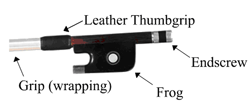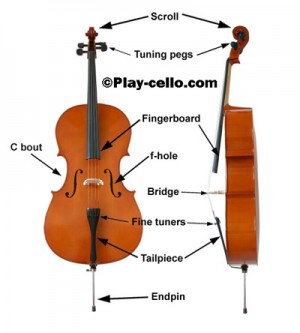The cello doesn’t look that complicated from the start. Besides being very large, this instrument has an amazingly specific design. Every part of the cello, including features that appear to be for decoration, like the small holes on the front of the instrument, are necessary for achieving the low tone beloved by listeners around the world.
The Body of the Cello
The cello’s body can be made from wood, carbon fiber, or even aluminum. Wood is the most common and traditional choice, usually a spruce/maple combination, or more rare poplar and willow. Cheaper cellos may use lower quality materials like laminated wood. Cheaper cellos are also factory produced, while higher quality cellos are carved by hand. The cello’s body has a wide top section, a narrower middle section, and a wide bottom section, somewhat resembling an hourglass shape. The cello’s front has a bridge, which holds the strings up from resting against the wood. Also, holes shaped like the letter “f” are on the front of the cello, and these holes play an integral role in the cello’s sound. A decoration known as “purfling” helps preserve the integrity of the cello, helping to protect the instrument from weathering damage and cracks.
The Neck and Strings of the Cello
The neck of the cello extends above the huge body. Attached to the neck is the fingerboard and various other parts to fashion the strings on. Cellists can choose from a wide array of strings, mostly made of metallic materials wound around a gut, metal, or synthetic core.
The Bottom of the Cello
At the cello’s bottom, we find the tailpiece and endpin. The part called the “tailpiece” secures the strings to the lowest part of the cello. The tailpiece may be made of plastic, steel, or a hard wood such as ebony. The “endpin” is the spike added on during the 19th century to improve the support of the cello during playing. The endpin can be made of carbon fiber, metal, or wood. Endpins these days may even be removable, retractable, or adjustable in height.
The Insides of the Cello
Inside of the cello is a bass bar and a sound post. The bass bar works to support the structure of the instrument and handle the vibrations caused by playing. The bass bar is located under the bass foot of the bridge. The sound post is wooden, round, and under the treble side of the bridge. This piece of the instrument connects the cello’s back and front. Both of these parts are vital in distributing the vibrations to the proper parts of the cello.
The Bow
Every single part of the cello is vital to its performance, and must be cleaned and cared for to produce the most beautiful music the instrument is

capable of.The bow, is most often made from a very particular type of wood from the pernambuco or brazilwood tree. This wood is very dark and heavy, and as a bow it channels the vibrations of the cello well. Bow hair can come from horses or found synthetically manufactured.

